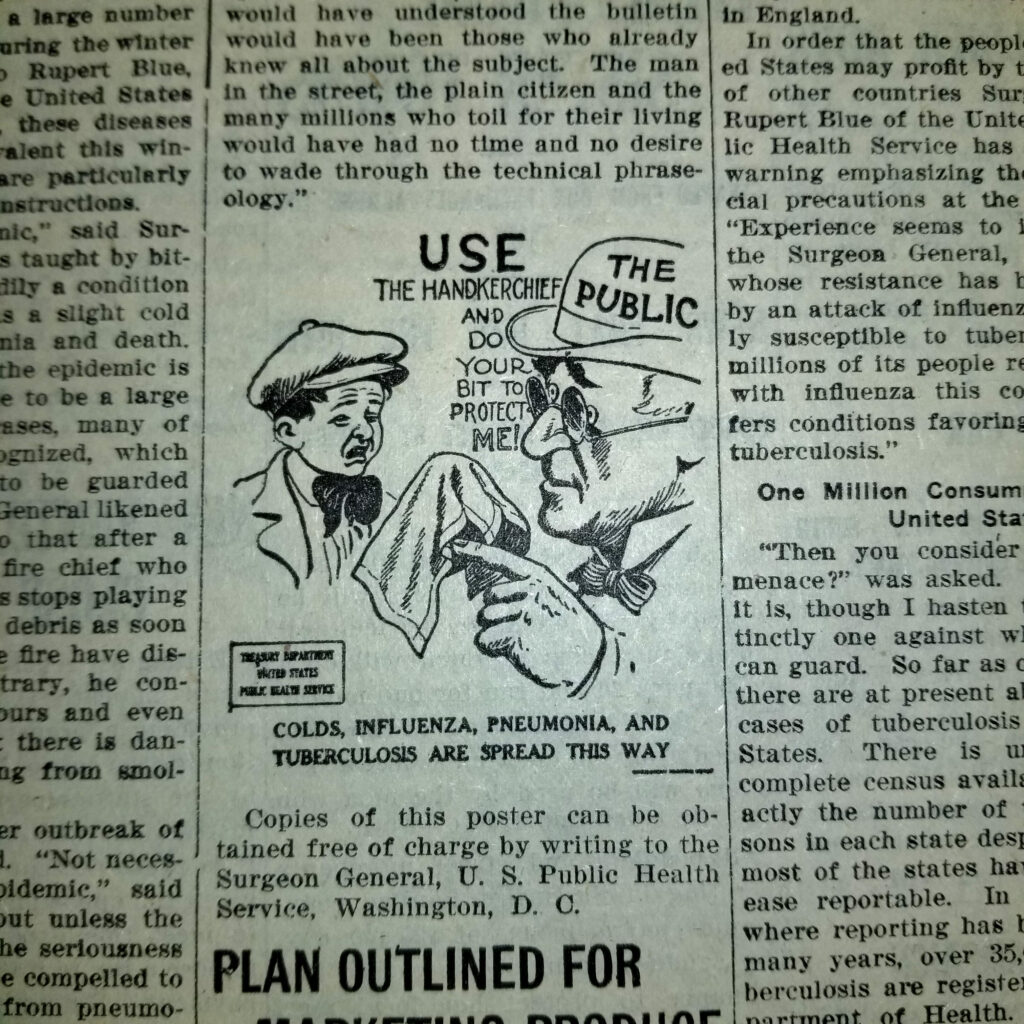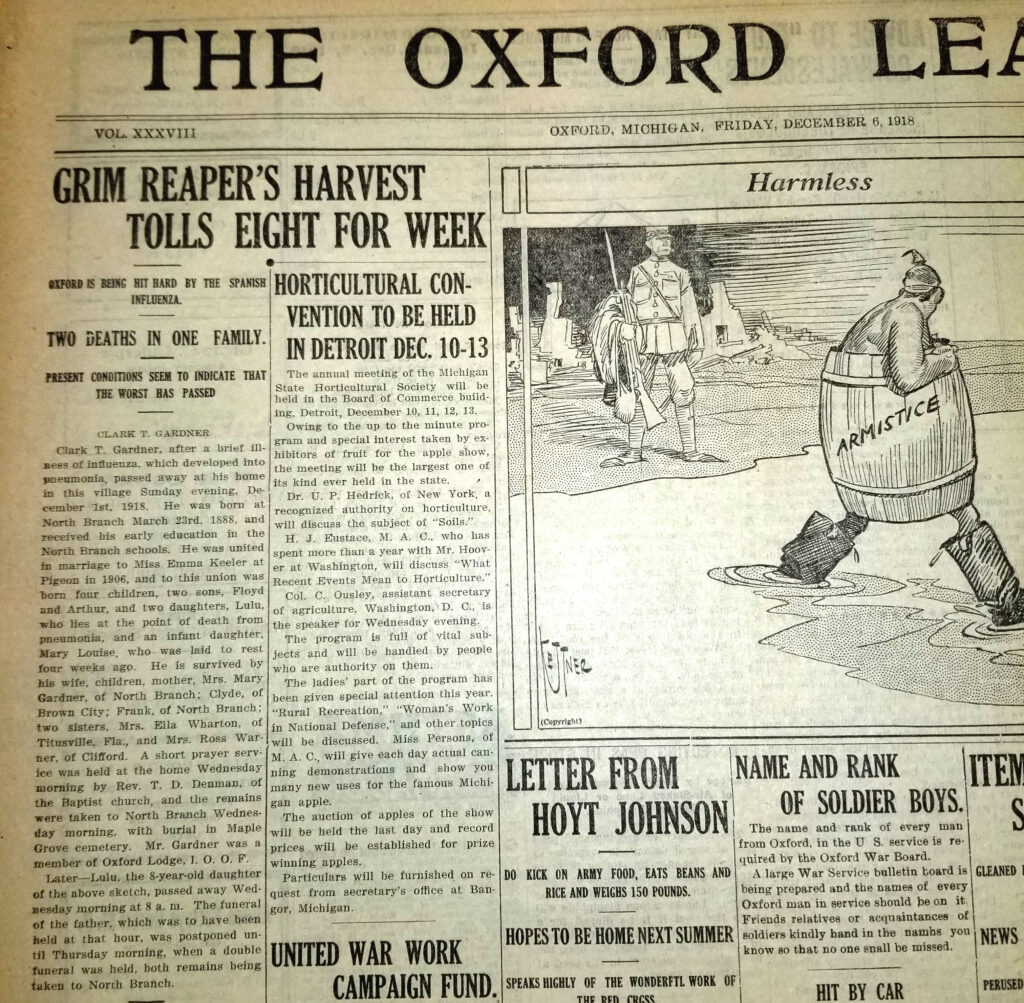
A look through The Leader archives at the 1918 Flu
By James Hanlon
Leader Staff Writer
The COVID-19 pandemic is said to be a once in a century event, often compared to the so-called Spanish Influenza of 1918. Taking a look back through The Oxford Leader’s 123-year archive reveals that although the last year was unusual for Oxford, it was not unprecedented. In the distant past, Oxford saw school, event and business closures, public health campaigns promoting social distancing and something akin to mask-wearing, all in response to disease outbreak.
The influenza reached Oxford in the fall of 1918. In early October, The Leader ran a U.S. Public Health Services bulletin, acknowledging the epidemic was “probably not Spanish in origin,” and warned against “droplet infection.”
By Oct. 25, Oxford Opera House’s weekly movie program ad announced the Opera House was closed “By order of State Board of Health. Kindly watch our sign board for reopening date.”
Other event announcements included tentative disclaimers, such as this Sunday school conference: “Anticipating that the present epidemic will be under control by November 3 the County Sunday School Association has plans well under way of one-day-to-a-town conference institutes…”
The Village of Leonard reported that, “There were no church services Sunday but there are no cases of Spanish Influenza in town.”
On Nov. 1, the school in North Oxford “has closed on account of the influenza.” The paper printed the names and condition of locals with the flu.
The outbreak even affected the November election of that year, by interrupting the work of local activists. “Fearing possible objections on account of the influenza epidemic, the Committee on Equal Suffrage halted their work of a house-to-house canvass for signatures to the petition, and because of the ban on public meetings, all plans for mass meetings and speeches were given up,” a Nov. 1 article said. “With perhaps half of the women in the Township reached there were 334 signers. . . Many have expressed regret at not having an opportunity to sign before the petition was sent to Pontiac.”
Seymour Lake School reopened Nov. 4, after a ten day closure. “There are no cases in the community, but the school board closed the school as a preventative measure.”
The Nov. 15 issue of the paper was overwhelmed by news and celebrations heralding the end of World War I. Things were opening up again amid a spirit of jubilation and optimism from the armistice. Indeed, war coverage overshadowed the influenza with letters from soldiers overseas, or news of local service members returning home.
“We are thankful that none of our pupils who have been suffering from the prevailing epidemic were dangerously sick,” the School Notes bulletin stated. “Some of them have returned and we hope that they all will be with us soon. We safeguard the health of our pupils in every way we can. Oxford as compared with neighboring towns is remarkably healthful just now.”
The Methodist Church resumed services Sunday, Nov. 17, after having closed for several weeks. “As much as we regret closing the churches, yet we are loyal to the authorities and are ready to do all we can to check the spread of the influenza and stay its ravages,” the church wrote.
The reprieve would not last. What followed was a back and forth series of reluctant closures, frustration, and intentions to reopen, not unlike the present day. On Nov. 22, the opera theater, which had hoped to reopen Nov. 16, ran another notice, this time closing voluntarily. Other events at the theater, including concerts and lectures, were likewise cancelled.
Sadly, Nov. 29 reported more casualties, with two victims of influenza claimed in one day. A Dec. 6, 1918 headline read, “Grim Reaper’s Harvest Tolls Eight for Week.” A subline reported two deaths in one family, yet “Present Conditions seem to indicate that the worst has passed.” Obituaries for each followed, most of them children or young people.
“Teachers do not enjoy this enforced inactivity. We would far rather be in school,” the School Notes said. Meanwhile, the Seymour Lake School, which had been closed for another two weeks while the teacher had the illness, reopened Dec. 9, following her recovery.
Dec. 13 announced the intention of area churches to resume services after being closed for seven of the last eight Sundays. “Unless there is a further outbreak of influenza the churches will again be open for the usual services next Sunday. It is sincerely hoped there will be no further need for closing orders.”

Unlike 2020, masks don’t seem to have been widely used, as their only mention was by U.S. Surgeon General Rupert Blue, advising caregivers in a syndicated health bulletin. “Nurses and attendants will do well to guard against breathing in dangerous disease germs by wearing a simple fold of gauze or mask while near the patient,” he said. Otherwise, handkerchiefs seemed to be the preferred fashion.
Dec. 6 ran a U.S. Health Service poster drawn by Clifford Berryman, a Pulitzer Prize winning political cartoonist. It shows a man labeled “The Public” holding a handkerchief and scolding a child with the caption, “Use the handkerchief and do your bit to protect me!”
Nearly 50 years later, in a special Aug. 19, 1976 Oxford Centennial edition of The Leader, local historian Margaret Stoddard recalled an odd preventative superstition from 1918:
“During the Flu epidemic the school children in Oxford wore ‘Fetty bags’ to ward off the deadly disease. These were made by our mothers out of unbleached muslin with drawstring tops. The bags were about an inch and a half long and about an inch wide. They were filled with asafetida and cake camphor crystals and were hung around our necks with an ordinary piece of string, positioned so that with every breath we got a whiff of the combined camphor and asafetida fumes.
“Now camphor fumes are not too unpleasant but the other ingredient was something else. We used to beg not to have to wear them but since everyone, even our teachers wore them, we were in good company.
“There may have been cases of the Flu in the Oxford school but I do not recall any and I believe the school board set the rule that we all must wear them. In fact, most everyone in town wore one and perhaps it might not be such a bad idea to try it again should the prediction of an epidemic this fall prove true.”
The newspaper was full of flu advice in late 1918, like common sense repeated today, “Avoid crowds in poorly ventilated places, avoid use of drinking cups and towels that have been used by others, when you have occasion to cough, sneeze or spit, turn your back upon your neighbor” and “scrupulous cleanliness and isolation from fellow workmen will do more to prevent the spread of disease than any use of antiseptics or medicines.”
Sure enough, along with helpful advice there were ads peddling remedies. “Foley’s Honey and Tar is just what every sufferer of influenza and la grippe needs now” ran for many weeks, while Oxford druggist R.F. Price prescribed “Listerine of Glyco-Thymoline” to gargle as a preventative.
In the same issue, a joke was printed, “Medicines to prevent the flu are nearly as numerous as the disease itself. Still, a sip of dope in time may avoid the expense of a funeral.”
Besides advice, there were plenty of opinions and terse witticisms. A Nov. 8 column provocatively recommended ignoring the flu in order to avoid it. “Psychology has something to do with catching the dreaded influenza. Our mental attitude either strengthens or weakens us. Let every man, woman and child FORGET all about the flu – don’t think of it at all. Cherish no dread; be possessed with no fear. Then – live rationally and follow every possible safeguard against the disease. Take no chances; live properly; avoid crowds; stay at home unless engaged in a war work; know the medical rules and keep them. The chances then are strong that you will live to tell your descendants of having safely navigated thru an influenza epidemic that killed many thousands.”
A Dec. 27 tip argued just the opposite, “The best way to ward off the influenza is to be ‘scared to death.’ Many is the man who wouldn’t be alive today were it not for the fact that he got scared enough to take good care of himself.”
Another one-liner quipped, “The war truly has killed its thousands, but the influenza its tens of thousands.” An accurate accounting of the number of influenza cases and deaths in the Oxford area is probably impossible, but The Leader reported dozens of deaths the winter of 1918-19. As of March 7, 2021, Oakland County has reported 14 total COVID-19 deaths for Oxford and Addison zip codes. The 1918 Flu affected the area for a few short months, but the coronavirus has put the community on a slow burn for an entire year now.
The Opera House’s weekly movie program finally resumed New Year’s Day, 1919 with a screening of Jack Pickford in “The Varmint.” Things seemed to have returned to normal by January, with regular church meetings, social events and even performances. At school, attendance “is good and improving.” The only mentions of influenza were status updates on folks who were recovering and a few more obituaries into February. The disease wouldn’t return for another year.
“The influenza epidemic came back after all,” the Feb. 12, 1920 issue declared, “just after the nation had got through laughing at the doctors for forecasting it. Oxford also hopes the doctors stay right in predicting that it will remain of a mild type. That doesn’t mean, however, that anyone should be less careful.” The Leader reported a small number of influenza deaths through the early months of 1920 as the pandemic’s last wave fizzled out.
Thanks to a partnership between The Oxford Public Library, The Clarke Historical Library at Central Michigan University and Sherman Publications, The Oxford Leader’s entire archive can be viewed online. To access the archive, search the Digital Michigan Newspaper Portal at digmichnews.cmich.edu or visit the Oxford Public Library website miopl.org which will provide guests with a direct link. Once on the site, viewers can search for anything that The Leader or its previous names, Oxford Intruder, Oxford Leader (and Globe), published dating back to the first issue on April 15, 1898 through 2014. (More recent articles can be read on The Leader’s website, OxfordLeader.com)

Leave a Reply